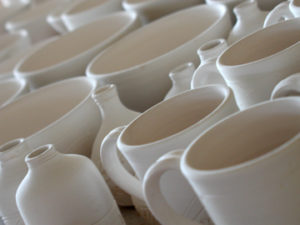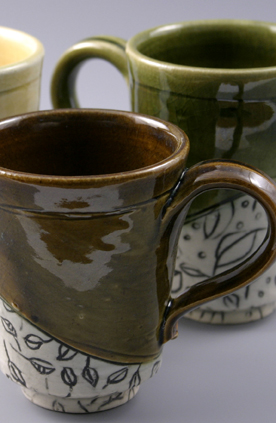fig.2-7
Shortly after graduating with my BFA, I bought the book, Ceramic Science for the Potter, 2nd edition, W.G. Lawrence and R.R. West. There were plans for graduate school but they were delayed – waited for in-state classification. So, I took it upon myself to continue some research. It began with the purchase of this book.
For those who own this book, cracked it open the first time and understood the text with relative ease, I would suggest you to be more science than potter. For others (like me) who sat down with the intent to uncover the answers to all your ceramic needs only to find yourself looking through the figured illustrations in an effort to connect the dots of the graphs with the appropriate words…focused…trying to really understand. Yeah, you are more potter than science.
 There are a few notes in the margins and a couple dog eared pages in my copy, but for the most part I dust it. Until recently.
There are a few notes in the margins and a couple dog eared pages in my copy, but for the most part I dust it. Until recently.
Early in May I found that I was having an absorption issue with my work. The percentage was too high. You can fairly accurately calculate the percentage of absorption of any given clay body by weighing a fired piece of clay to the nearest 0.1g. Then, place the fired piece in a suitable container and boil it for five hours. Afterward, reweigh the piece. The percentage of absorption equals the gain in weight divided by the original weight, multiplied by 100. Yeah, yeah…I didn’t do that. I knew I had an issue because I had a piece that was weeping or sweating when filled with water.
Now, I needed to find the most immediate solution. I made a list of possible jumping off points: glaze defects, glaze application, clay body…. As I ran through my list, I narrowed my problem to the clay body. I’ve used this particular clay for several years without an issue. This situation was frustrating.
Initially I focused on a glaze defect because I found that not all the pieces were affected. However, after resolving the defect, I still had an issue – though not with all the pieces. However, what I did have was the most recently purchased remains of 500 pounds of clay. That would account for the inconsistent results. It may also point to a change in the recipe of the clay body, or a change in the mining location of a raw material, or…or…or…. Regardless, this wasn’t something I could control. My solution here would only be a higher firing temperature. That change would require me to begin from scratch. Overwhelming thoughts of overwhelmed!!
In the meantime, I sold my clay to a sculptor and bought an old tried and true clay body – one with a tighter more plastic character. I anticipate good results, but am anxious for the first glaze load.
 Not necessarily satisfied with just knowing the clay was the culprit in the demise of several pieces (picture the shard heap topped with dozens of mugs), I dusted off my copy of Ceramic Science for the Potter, 2nd edition, W.G. Lawrence and R.R. West.
Not necessarily satisfied with just knowing the clay was the culprit in the demise of several pieces (picture the shard heap topped with dozens of mugs), I dusted off my copy of Ceramic Science for the Potter, 2nd edition, W.G. Lawrence and R.R. West.
Here I discovered two things:
1) A more probable answer to the clay situation.
2) I actually understand some of this book (you can say it: geek!).
But, I digress. So, let’s start with the figured illustrations and work our way back to the appropriate text. There it is – Fig.2-7, “Effects of firing temperatures on the absorption of plastic, medium plastic and short clay.” The authors don’t go into a lot of details, the graphics are self-explanatory. In fact, they meander into instructions for building a Globar thermal furnace for testing – because, of course, any potter with their nose stuck in this book must be planning to do an inordinate amount of differential thermal analysis. (help me!) Again, more science than potter.
At any rate, Fig.2-7 reminds me that plastic clay (clay that can be manipulated and still maintain its shape without cracking or sagging) matures at a lower temperature than short clay (clay that is not plastic – see previous definition). Newly made clay is often refered to as short. So, I theorized that my new lot of clay wasn’t just new to me, it was quite possibly actual new clay.
You know, I often ask myself why I don’t just draw…like, on paper. What’s wrong with me? Don’t answer that.
19 Comments
Comments are closed.
All sounds very technical to me!
I know that I buy your pottery because I find it beautiful, moving. The fact that I can cook with it, is an added benefit!
It all sounds very technical to me too.
There is nothing better than when some one actually uses the pieces they buy!
It is technical, but more importantly, beautiful!
Beth, This is like a nightmare for a potter! It makes my head swim. And after that batch of silica that drove you nuts too. So, what clay were you having problems with? I really don’t want to have the some problem if Marjon’s is getting bad clay or if I need to age the clay a bit before using.
Genie, it’s not a clay you usually use. Besides the distributors wouldn’t know how long a bag of clay sat. Who knows, perhaps if I had started that lot of clay with a different box, things would have been different. Still, this provided a learning opportunity. I’m cool with that.
You really wanna make yourself crazy, you could put the problem out there on the Clay Art list; they’ll go bananas with theories and ways to test it.
Oh Lisa, I’m way past the crazy part…too busy recreating an inventory. They would have a hay day with it though.
I had the same problem with my cone 06 course red sculpture clay. Bisque firing to cone 02 did not solve it. So I now put a tiny little hole at the top of my vases and write on the bottom “Not intended to hold liquid.”
Beth, you are certainly an extension of God’s hands (the greatest Creator of all)!!! You work through your situations to create items of beauty!! God bless you!
Beth, So have you tried the glazes on a different clay to see if the clay was the problem?
Genie, I pretty much eliminated the glaze as the issue…which only left clay as the culprit. If you read up a couple comments to Sandy’s note – though not an everyday concern, it’s probably not as uncommon as we think.
Beth:
Genie gave me the link to your blog because I told her about my “sweating”/”weeping pots. About four or five years ago I made some functional wares from three types of Laguna cone 5 clay. Every one of those pots had water sipping problem. Do you remember when you bought those clay?
Wen-Ling, I bought that clay in April, 2010. Truthfully, I’m not sure I can isolate the exact cause in the clay body – there are several possibilities. I use to make my own clay and one would think that would solve any issues. But even in that case I can’t control the mining of the raw materials. It is frustrating – especially considering all the lost work. Sometimes mysteries are just that. Perhaps I would do well to test the clay before I jump into work…no, I won’t be doing that. Got to just keep working. I hope you’ve found a clay that’s cooperating for you now.
Wen-Ling, I gave you the wrong date. I bought the clay in question in January 2010.
You are very talented Beth. Life and talent would lose its savor without the challenge.
True enough, the challenge keeps me going.
Hi Beth,
What is the clay body you were using? I’ve never had this issue with Laguna or any other clay. Even if you were using an open body like WS-5 or O, if the glaze is OK it shouldn’t leek. What cone do you fire to?
Jim
Sonora White. Had been using it for years without any problems. I eliminated the glaze as the culprit. Definitely a clay issue. If you read a couple comments up to Sandy’s you’ll see she had a similar problem. It’s likely more common than we think. I fire to ^6.
leak ; )